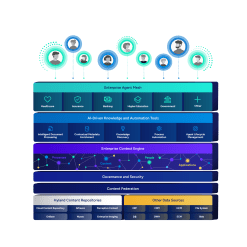
Content Innovation Cloud™
Harness the power of a unified content, process and application intelligence platform to unlock the value of enterprise content.
Learn moreInsert your title here
Insert your title here

Intelligent document processing
Automate your document-centric processes with AI-powered document capture, separation, classification, extraction and enrichment.
Learn about Hyland IDPIndustries
It's your unique digital evolution … but you don't have to face it alone. We understand the landscape of your industry and the unique needs of the people you serve.
 Overview of industries
Overview of industries
Departments
Countless teams and departments have transformed the way they work in accounting, HR, legal and more with Hyland solutions.
 Overview of departments
Overview of departments
Services
We are committed to helping you maximize your technology investment so you can best serve your customers.
 Overview of services
Overview of services
Insert your title here

Customers
Discover why Hyland is trusted by thousands of organizations worldwide.
Hear from our customers
Partners
Our exclusive partner programs combine our strengths with yours to create better experiences through content services.
Overview of partners
Resources
Find resources to power your organization's digital transformation.
Browse the resource centerArticles

Company
Hyland connects your content and systems so you can forge stronger connections with the people who matter most.
Learn about HylandWhy choose Hyland?
With our modern, open and cloud-native platforms, you can build strong connections and keep evolving.
 Dig deeper
Dig deeper

Hyland integrations
Hyland solutions surface and deliver critical content in context by connecting with 500+ unique applications. Elevate content visibility across the systems you rely on with Hyland.
41 results
Peoplesoft
The integration enables teams to automatically connect transactions in PeopleSoft with associated documents in the Hyland content services platform.
Accela
Provide instant, secure access to drawings and documents for developers, engineers, inspectors, project managers and more.
Seamless integrations with Google Docs and Drive increases collaboration and productivity while maintaining a single source of truth, controlling access and ensuring compliance.
Tempest Prospero
Give users instant access to the plan sets, reports and documentation they need from one central repository.
Adobe Sign
Learn how the OnBase Integration for Adobe Sign facilitates digital signature capabilities and meets today's business needs for more efficient operations.
MuleSoft
Integrate Hyland content services into your enterprise systems and enable publishing and syndication to social platforms and other cloud-based systems.
Nextgen
Automate key healthcare processes, improve outcomes and increase staff satisfaction across departments by integrating OnBase content within NextGen workflow.
Microsoft Outlook
Connect your content with Outlook for a complete, efficient view.
Cerner
Hyland enriches your EHR investment by capturing, classifying and integrating images and unstructured patient records for clinician access within the Cerner workflow.
Cognizant
Gain a complete view of member or provider information with Hyland’s integration with Cognizant’s core admin products: Trizetto CareAdvance, QNXT or Facets user interface.